List of Authors
>>About this blog
Recent blog post
|
[CAM]
May 7, 2018 12:00
From April 29th, NHK Special started a new series "Oedo". "Edo, the largest Lost City in Japanese history, disappeared 150 years ago in 1868. I draw the unknown figure in a variety of productions, including documentaries, 4KCG, and drama expressions," (NHK website).
Of the three sessions, the theme of the first (April 29) is "World's largest! ! It was the "city of water" built by Samurai. Based on the recently discovered drawings depicting urban planning in the early Edo period and photographic negatives of late Tokugawa shogunate, he revealed that Edo was "a unique city that was built using water and was unique to the world."
As is well known, Chuo-ku is "the first Edo", so drawing "the capital of water, Edo" almost overlaps with the original form of "the former town of water, Chuo-ku, Tokyo". From the Chuo-ku Board of Education Chuo-ku Local Tenmonkan, "The History of Chuo-ku, commemorating the 70th anniversary of the constituency system-development after the war and changes in towns-" (October 2017), from page 10, "Reclaiming post-war reconstruction rivers" , Page 14 states "Maintenance by the Tokyo Olympics and Reclaiming rivers". On page 10, the reclamation of rivers since the reconstruction of the earthquake is summarized on a map, but it can be seen at a glance that many rivers in Chuo-ku have been reclaimed by the earthquake reconstruction, the war reconstruction, and the Tokyo Olympics. .
[CAM]
May 2, 2018 14:00
On April 28, the Nikkei Shimbun, page 26, describes the fact that Matsuo Basho lived in Nihonbashi.
Basho descended from Iga Ueno to Edo in 1672 (Kanbun 12) to become a haiku master. In the winter of 1680 (Yonho 8), he retired by connecting an hermitage to Fukagawa, which was still a suburban area, but it is thought that he lived around Nihonbashi until he moved to this later hermitage called "Bashoan". I am.
According to the recently deciphered ancient document, Basho's address at that time was "Odawaramachi Taro Ozawabei", Odawaramachi was now 1-chome Nihonbashi Muromachi, and at that time it was a busy place near the fish market.
According to subsequent research, it seems that it is a common theory that Basho had been in Odawara-cho since around 1677 (Yonho 5).
Near the opposite side of Chuo-dori from Nihonbashi Mitsukoshi, Nihonbashi Funasa, a long-established Tsukudani store located in Muromachi Koji, known as "Hakuya Matsuo Momo Aojuku Spring" stone monument, which is thought to have been written around this time.
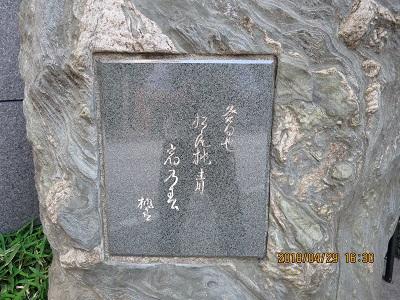
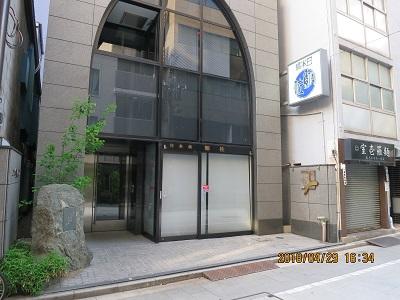
[CAM]
April 7, 2018 12:00
In the last post on "Population Estimation of Chuo-ku", we correct some errors and supplement them.
>In "Chuo-ku Monoshiri Encyclopedia", on page 87, "Population Change in Chuo-ku" ... In 1998, the population increased for the first time in 45 years, "297 people" compared to the previous year, and in April 2006 He stated that he had achieved 100,000 for the first time in 31 years since 1 years since 1975 years.
Then, in the previous article, "In the Tsukuda area where I live, we are blessed with a space of 'green and water', such as Tsukuda Park, Ishikawajima Park, and Sumida River Terrace, so the ' merits of accumulation' due to population increase (local vitality and improvement of living convenience) will further increase, and we will eliminate the demerit of overcrowding population. "
In connection with this, Mr. Takuro Morinaga pointed out that "Tokyo is now" Edo "" in terms of population growth in central Tokyo ". As is well known, Chuo-ku (former Nihonbashi-ku / Kyobashi-ku) is the first Edo.
http://www.1242.com/lf/articles/48592/?cat=life&pg=happy
Morinaga) Edo is very small in the area, and everyone lived in a place smaller than the inside of the current Yamanote Line. Well, it was a million city, but there was Samurai residence around the present Imperial Palace, where 60% of Edo's samurai lived in 500,000 people, but the remaining 20% is temples and shrines. The monks lived, and 500,000 townspeople lived in the remaining 20% of the land. It's just a tenement house.
Morinaga) So this tenement house is very narrow. However, there were many fires, but live widely with as little things as possible. So what the common people of Edo were doing is, for example, going to listen to rakugo. You can enjoy Kabuki or sumo wrestling.
Morinaga) It's just like (now). I'm going to enjoy the live show. It's a lifestyle.
Morinaga) (The former tenement house was spread sideways, but now it's like a tower apartment) just getting higher, and what you're doing is exactly the same.
―From the blog post of FM93AM1242 Nippon Broadcasting Corporation―
[CAM]
April 2, 2018 12:00
In "Chuo-ku Monoshiri Encyclopedia", on page 87, the population of Chuo-ku increased to 172,183, which peaked in January 1953, and in April 1997, the lowest in the previous year to 71,800, compared to 71,800, and 198,000.
According to the Nihon Keizai Shimbun on March 31, 2018, the Tokyo Metropolitan Institute of Population and Social Security (Tokyo Metropolitan Institute of Population and Social Security, 30% more than 2015), according to the headline, "The Tokyo Metropolitan Institute of Population and Social Security (Tokyo Metropolitan Institute of Population and Social Security, 30% more than 2045), according to the 30-year projections. (Chiyoda, Chuo, Port) increased by more than 30% compared to 2015. On the other hand, local governments with a double-digit decline rate in the Tama area are conspicuous. The population gap between local governments is likely to spread even more in Tokyo.
The three wards of central Tokyo will have about 443,000 people in 2015, an increase of about 595,000 people in 1945. "Condominium construction has been carried out one after another, and the population has increased more than expected. I think this trend will continue in the future. The three wards accounted for the top three in the rate of increase by municipality nationwide.
Chuo-ku has the largest increase in the three wards of central Tokyo with 34.9%. According to the previous estimate (2013), the population in 40 years increased by 14.4% compared to 10 years, and the pace of increase is accelerating. "The estimated population in Chuo-ku in 2045 is 190,000.
If we proceed according to this estimate, the peak population in January 1953 exceeded 172,000 in 2045.
You may be worried about the disadvantages of overcrowding population, but in the Tsukuda area where I live, we are blessed with "green and water" spaces such as Tsukuda Park, Ishikawajima Park, Sumida River Terrace, etc. The environment will eliminate the disadvantages and increase the merits of accumulation due to population growth (improvement of regional vitality and convenience of living) will further increase.
Below is the scenery of Ishikawajima Park on March 24.
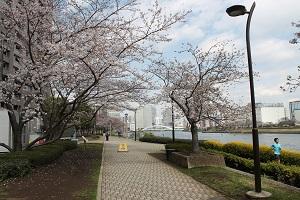
[CAM]
March 26, 2018 12:00
It's a little earlier than usual, but the cherry blossom season has come again this year. Saturday, March 24, the weather was good and it was a great walking day.
I'm ashamed that it's just a series of snaps that doesn't change every year and has no much ingenuity, but I'll introduce a little with the intention of fixed-point observation.
From Ishikawajima Park, you can see Chuo-ohashi Bridge. It was almost in full bloom here.
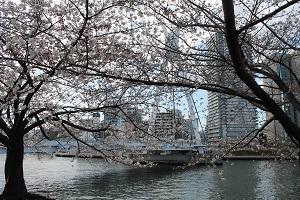
From Tsukuda and River City, we crossed the Chuo-ohashi Bridge, and looked at the cherry blossoms on the Sumida River riverside at Ishikawajima Park from the vicinity of the reishijima tide center and the water mark in Shinkawa.
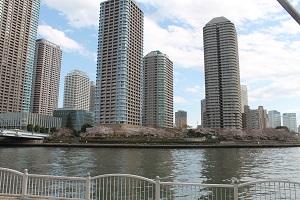
It's Akatsuki Park (7-19 Tsukiji). There is a bust of Siebold.
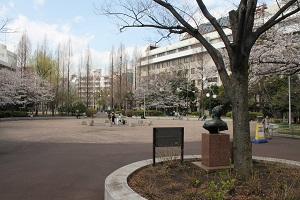
From the St. Luke's Tower, look at Kachidokibashi and Tsukiji Ohashi. It is a pity that the observation room on the floor has been abolished.
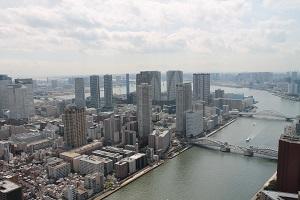
From the front of St. Luke's Tower, I wanted to see Tsukuda.
![IMG_3899[1]. jpg](https://en.tokuhain.chuo-kanko.or.jp/archive/2018/03/25/IMG_3899%5B1%5D.jpg)
Cross the Tsukuda-ohashi Bridge, return to Tsukuda, and Tsukuda Park.

Ishikawajima Park.
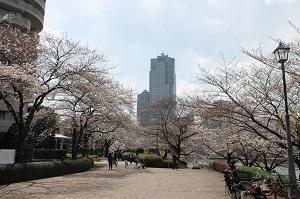
[CAM]
March 3, 2018 12:00
On March 1st, it was as cheerful as the end of April, reminiscent of "spring near", and the walking feet headed along the Sumida River. From the top of Chuo-ohashi Bridge, I could see the Sky Tree clearly.
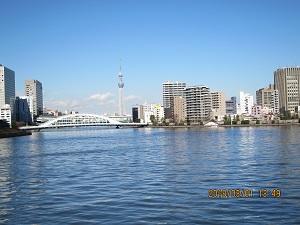
Kawazu cherry tree on the riverbank was already in full bloom.
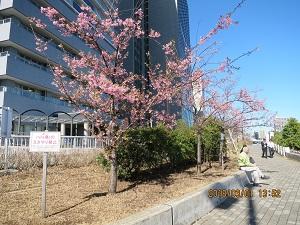
The cherry blossoms on the riverbank were also looking forward to flowering. Is it only three weeks before the cherry blossom season?
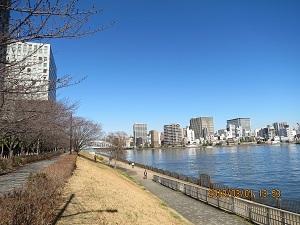
When I walked on the Sumida River Terrace, it was so cheerful that I was sweating, and it had a taste of "water mud".
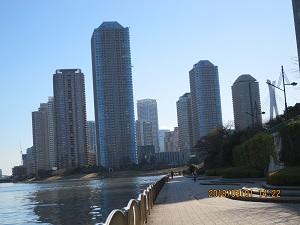
|
Links
|
![IMG_3899[1]. jpg](https://en.tokuhain.chuo-kanko.or.jp/archive/2018/03/25/IMG_3899%5B1%5D.jpg)

